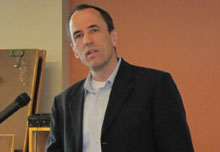Event
Panel looks at the possibility of trying to ‘fix’ the earth’s climate

March 31, 2010 — The third and final event in the Climate Change and the Media Seminar Series, “Techno-Optimism or Pessimism: ‘Fixing’ the Planet’s Climate Problems,” lived up to the dramatic promise of its title. There was no lack of stark images, dramatic turns of phrase, and daring ideas so far out there that, as Jeff Goodell of The New York Times said, they just might work.
Goodell was joined on the panel by Time magazine‘s Bryan Walsh, author of the newsweekly’s “Going Green” column. The discussant was Matthew Bunn of the Belfer Center for Science and International Affairs, which cosponsored the event, and Cristine Russell of the Belfer Center moderated. She started conversation by saying that the climate change issue in all its complexity and controversy was fundamentally “a political story,” a fact underscored by a recent visit by President Obama to Iowa, a key battleground state.
In his opening remarks, Walsh described energy coverage as a “breathless cycle of hype followed by disappointment,” pointing to companies such as Nanosolar that got a lot of attention only to fall short. “Two years later, the energy industry is still pretty unrevolutionized,” Walsh said. He expected that the latest hope, the Bloom Box, will produce similar results. He summed up the possibility of the United States transitioning quickly to a clean-energy economy with five words: “There won’t be a savior.” Goodell noted that one entrepreneur was doing well producing cookie flour made with the algae byproduct of his energy-production process, but hadn’t yet transformed how the U.S. gets its power.
He recalled how doing research on his 2006 book, Big Coal, opened his eyes to how we got energy. While he’d reported on Silicon Valley for years, he’d never once thought about where electricity came from. Staring into an open-pit coal mine was “kind of [like] opening the door to the slaughterhouse,” he said. “This is what’s behind our iPods, iPhones, iPads.”
While Goodell was aware of the negative impact of high-carbon fuels on the earth’s climate, “It became very clear to me that we weren’t going to stop burning this stuff anytime soon.” He began doing research on for what would become his latest book, How to Cool the Planet: Geoengineering and the Audacious Quest to Fix Earth’s Climate. ” ‘Maybe we can…’ plays into that part of the American psyche that runs really really deep. It also plays into the other side, which is that fear of technology.” Ultimately, however, he felt that “there’s kind of a long-term inevitability in this.”
In framing the discussion, Bunn noted: “Scale is the fundamental issue. We don’t really understand as a society just how big this challenge is.” A 2006 paper by Nobel laureate Paul Crutzen suggested that adding sulfur to the stratosphere could offset greenhouse gas warming, but do we really know what the consequences would be? “It’s going to have side effects that we don’t understand,” Bunn said.
The participants noted that fundamentally, geo-engineering isn’t just a science and technology issue, but a political and moral one. “It’s easy to have the power,” Bunn said, “but do you have the right?” At the same time, Walsh noted dryly, “We’re already geoengineering the planet. We’re just doing it by accident.”
Article and photos by Leighton Walter Kille of the Shorenstein Center.